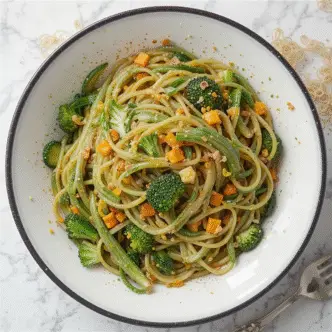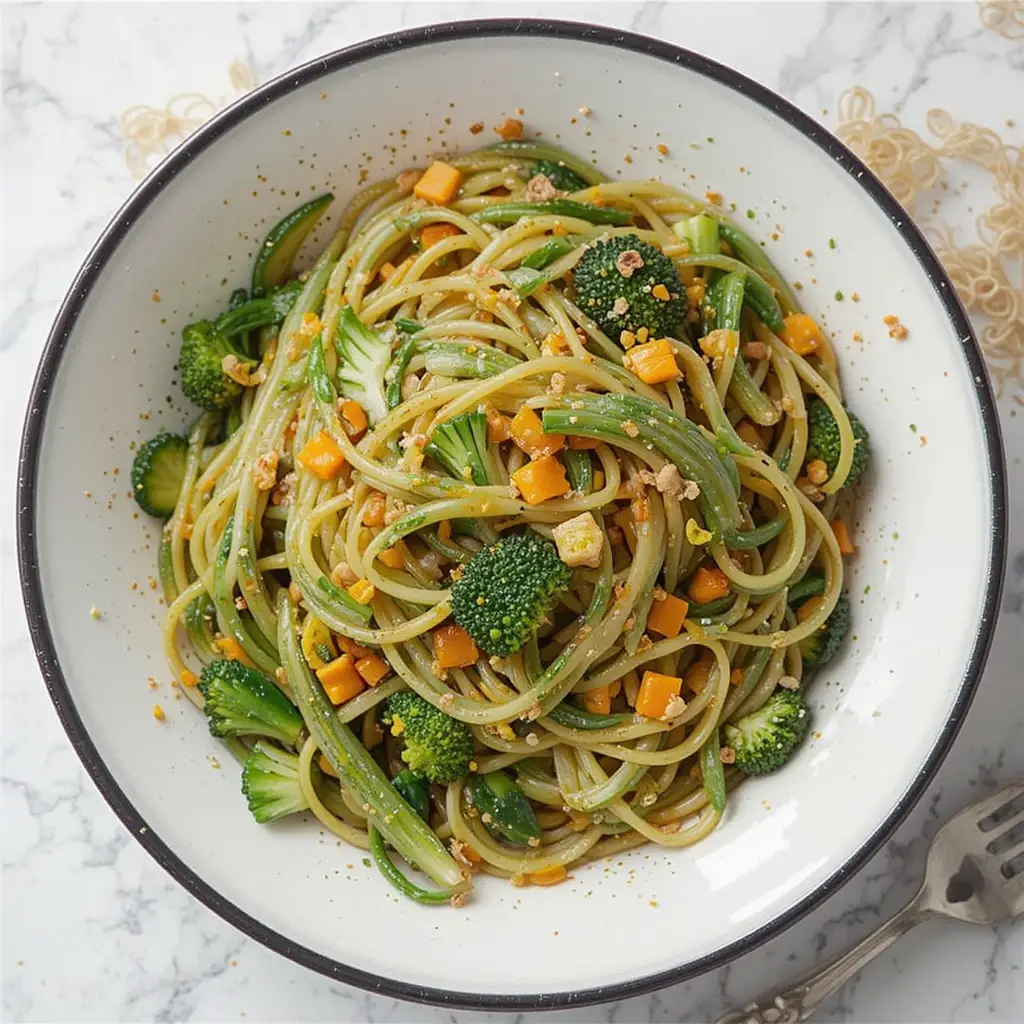Soy noodles blended with vibrant vegetables offer a nutritious, high-protein, and delicious meal that is easy to prepare and perfect for any time of day. This dish, rich in plant-based protein and essential vitamins, is a quick-fix culinary delight that balances health with flavor. Whether you're a busy professional or a home cook looking for a fast and healthy option, this recipe is designed for convenience without compromising on taste.
Ingredients You Will Need
Before diving into the process, here’s a list of essential ingredients you’ll need to prepare this satisfying soy noodle dish:
-
200 grams of soy noodles
-
1 medium-sized carrot, julienned
-
1 red bell pepper, thinly sliced
-
1 yellow bell pepper, thinly sliced
-
100 grams of shredded cabbage
-
1 zucchini, julienned
-
2 tablespoons of soy sauce
-
1 tablespoon of sesame oil
-
1 tablespoon of olive oil
-
1 teaspoon of chili flakes (optional)
-
2 cloves garlic, minced
-
1 teaspoon of grated ginger
-
1 tablespoon of rice vinegar or lemon juice
-
Salt to taste
-
Freshly ground black pepper
-
Fresh coriander or spring onions for garnish
Why Choose Soy Noodles?
Soy noodles are a gluten-free, low-carb, high-protein alternative to traditional wheat noodles. Made from soy flour or soy protein isolate, they’re perfect for people following plant-based, keto, or gluten-free diets. These noodles absorb flavors remarkably well, making them a versatile base for a wide range of Asian-inspired or fusion dishes.
Step-by-Step Cooking Instructions
1. Prepare the Vegetables
Start by washing all vegetables thoroughly. Julienne the carrots and zucchini, and slice the bell peppers and cabbage finely. A uniform cut ensures even cooking and a visually appealing dish.
2. Cook the Soy Noodles
Bring a large pot of water to a boil. Add a pinch of salt and gently place the soy noodles in the boiling water. Cook for 4 to 6 minutes, or according to package instructions, until they’re tender but firm. Once cooked, drain and rinse with cold water to stop the cooking process and keep the noodles from sticking.
3. Stir-Fry the Aromatics
In a large non-stick wok or skillet, heat olive oil and sesame oil over medium-high heat. Add the minced garlic and grated ginger, sautéing for about 30 seconds until fragrant.
4. Add Vegetables
Add the harder vegetables first: carrots and bell peppers. Stir-fry for about 2-3 minutes, then add the zucchini and cabbage. Continue stirring for another 2 minutes until vegetables are tender yet still crisp. This ensures the dish retains its color, texture, and nutrients.
5. Season and Combine
Add the cooked soy noodles to the pan. Pour in the soy sauce, rice vinegar (or lemon juice), chili flakes, salt, and pepper. Mix everything thoroughly with tongs or chopsticks to ensure the noodles are evenly coated with the sauce and vegetables are well integrated.
6. Garnish and Serve
Turn off the heat and garnish with freshly chopped coriander or spring onions. Optionally, add a sprinkle of toasted sesame seeds or crushed peanuts for added crunch and nutty flavor. Serve hot for the best experience.
Nutritional Benefits of Vegetable and Soy Noodles
This dish is a nutritional powerhouse:
-
High in plant protein from soy noodles, perfect for muscle repair and vegetarian diets.
-
Rich in fiber, antioxidants, and vitamins from colorful vegetables.
-
Low in saturated fat and free from refined carbohydrates.
-
Contains healthy fats from sesame and olive oil that support heart health.
Customizations and Variations
1. Add More Protein
In addition to soy noodles, you can add tofu cubes, edamame beans, or tempeh for extra protein. If not vegetarian, grilled chicken, shrimp, or eggs also blend well.
2. Sauce Variations
Create depth of flavor by adding:
-
Hoisin sauce for sweetness
-
Sriracha or hot sauce for heat
-
Peanut butter (1 tablespoon mixed with warm water) for a Thai-style twist
3. Add Nuts and Seeds
Enhance the texture by adding roasted cashews, peanuts, or sunflower seeds.
Tips for Perfect Vegetable and Soy Noodles
-
Use high heat during stir-frying for that characteristic wok aroma.
-
Do not overcook the vegetables; they should retain their crunch.
-
Rinse the noodles with cold water after boiling to prevent clumping.
-
Adjust seasoning to taste, especially salt and soy sauce, to maintain sodium balance.
Meal Prep and Storage
Vegetable and soy noodles are excellent for meal prep:
-
Store in airtight containers in the refrigerator for up to 3 days.
-
Best reheated in a skillet over low heat with a splash of water or oil to refresh texture.
-
You can also enjoy them cold as a noodle salad, especially in warmer months.
Serving Suggestions
Pair your soy noodles with:
-
Miso soup or a light broth
-
Pickled vegetables or kimchi for a tangy contrast
-
Herbal tea or sparkling water with lemon for a refreshing drink
This dish is also ideal for packed lunches, quick dinners, or even as a main dish at a casual gathering.
Conclusion
This quick vegetable and soy noodle recipe is more than just a meal — it’s a celebration of flavors, textures, and nourishment. With minimal prep time and simple ingredients, this dish brings together the best of Asian cuisine with a healthy twist, making it a go-to recipe for clean eating and bold taste.













